International Finance & Decision Making: Financial Analysis
VerifiedAdded on 2023/03/23
|12
|3642
|52
Report
AI Summary
This report provides a detailed analysis of international finance and decision-making, covering key aspects such as accounting terms (relevance and reliability), the implications of listing on the Australian Stock Exchange (ASX), the principles of corporate governance, and the importance of the statement of financial position. The report examines the relevance and reliability of accounting information, emphasizing their significance in influencing user decisions and ensuring faithful representation. It further explores the advantages and challenges associated with listing a firm on the ASX, including increased investment opportunities and enhanced valuation, alongside potential costs and disclosure requirements. The principles of good corporate governance, such as establishing strong management foundations, ethics, transparency, and protecting shareholder rights, are also discussed. Finally, the report analyzes a financial position statement, using financial ratios to assess the company's liquidity, financial leverage, and overall financial health. Desklib provides a platform to explore similar solved assignments and study resources.
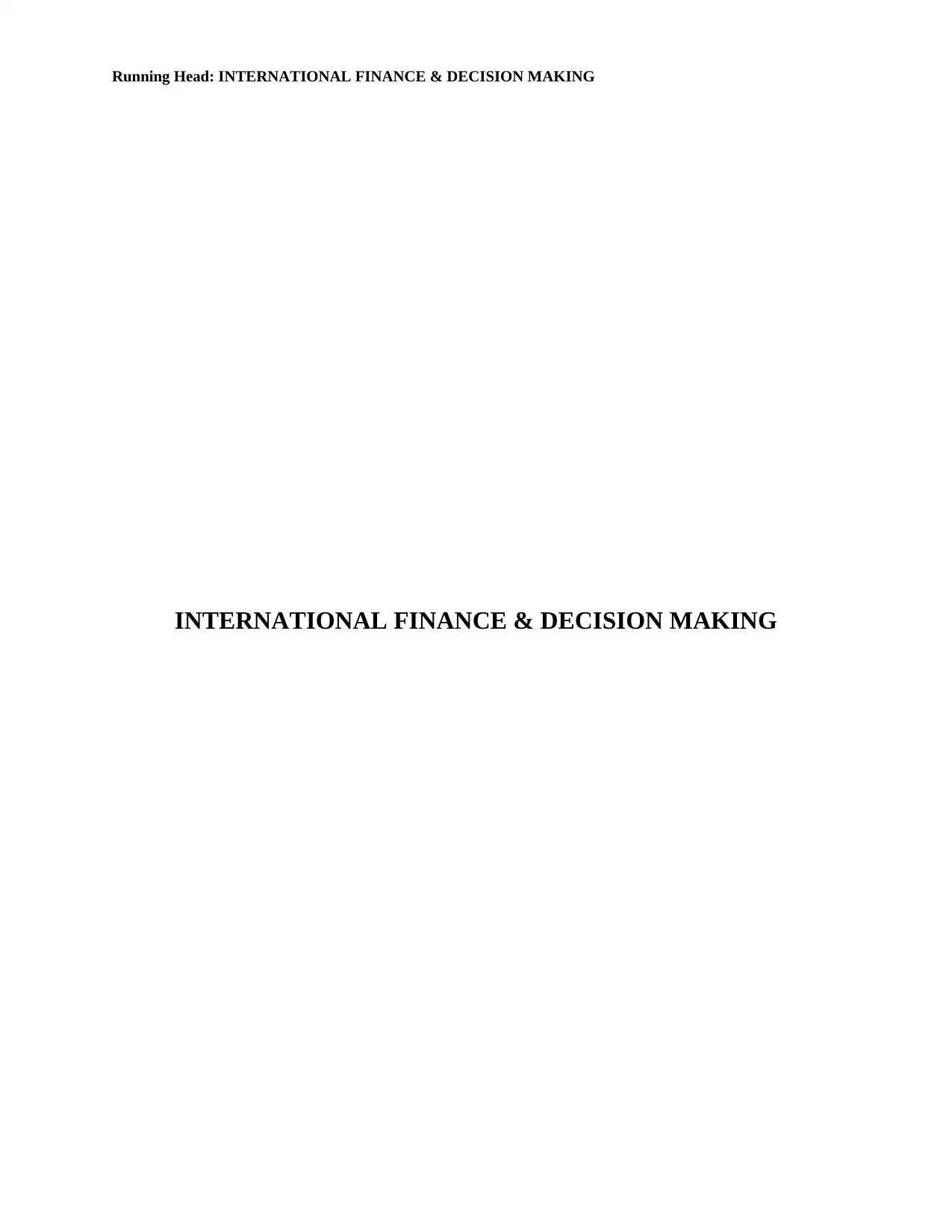
Running Head: INTERNATIONAL FINANCE & DECISION MAKING
INTERNATIONAL FINANCE & DECISION MAKING
INTERNATIONAL FINANCE & DECISION MAKING
Paraphrase This Document
Need a fresh take? Get an instant paraphrase of this document with our AI Paraphraser
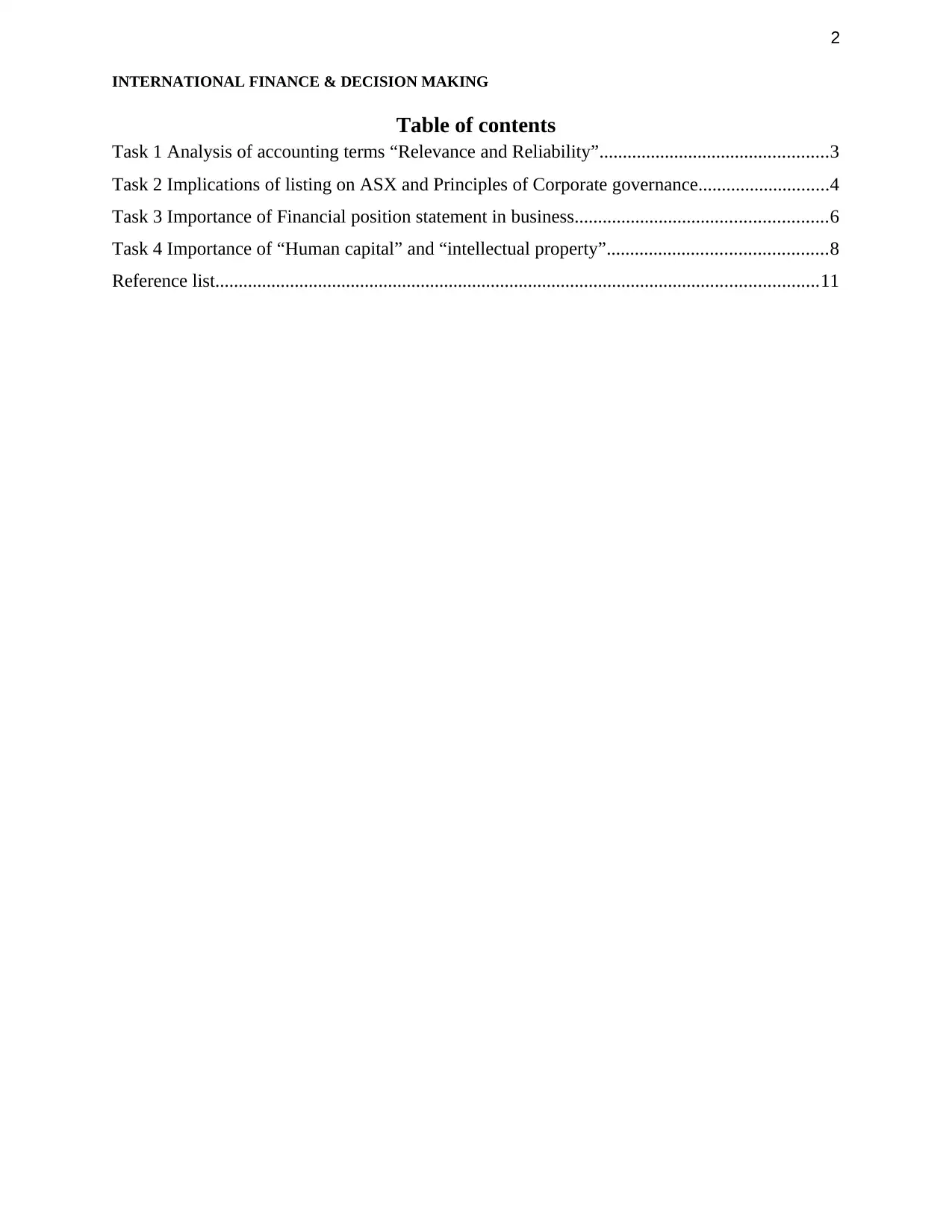
2
INTERNATIONAL FINANCE & DECISION MAKING
Table of contents
Task 1 Analysis of accounting terms “Relevance and Reliability”.................................................3
Task 2 Implications of listing on ASX and Principles of Corporate governance............................4
Task 3 Importance of Financial position statement in business......................................................6
Task 4 Importance of “Human capital” and “intellectual property”...............................................8
Reference list.................................................................................................................................11
INTERNATIONAL FINANCE & DECISION MAKING
Table of contents
Task 1 Analysis of accounting terms “Relevance and Reliability”.................................................3
Task 2 Implications of listing on ASX and Principles of Corporate governance............................4
Task 3 Importance of Financial position statement in business......................................................6
Task 4 Importance of “Human capital” and “intellectual property”...............................................8
Reference list.................................................................................................................................11
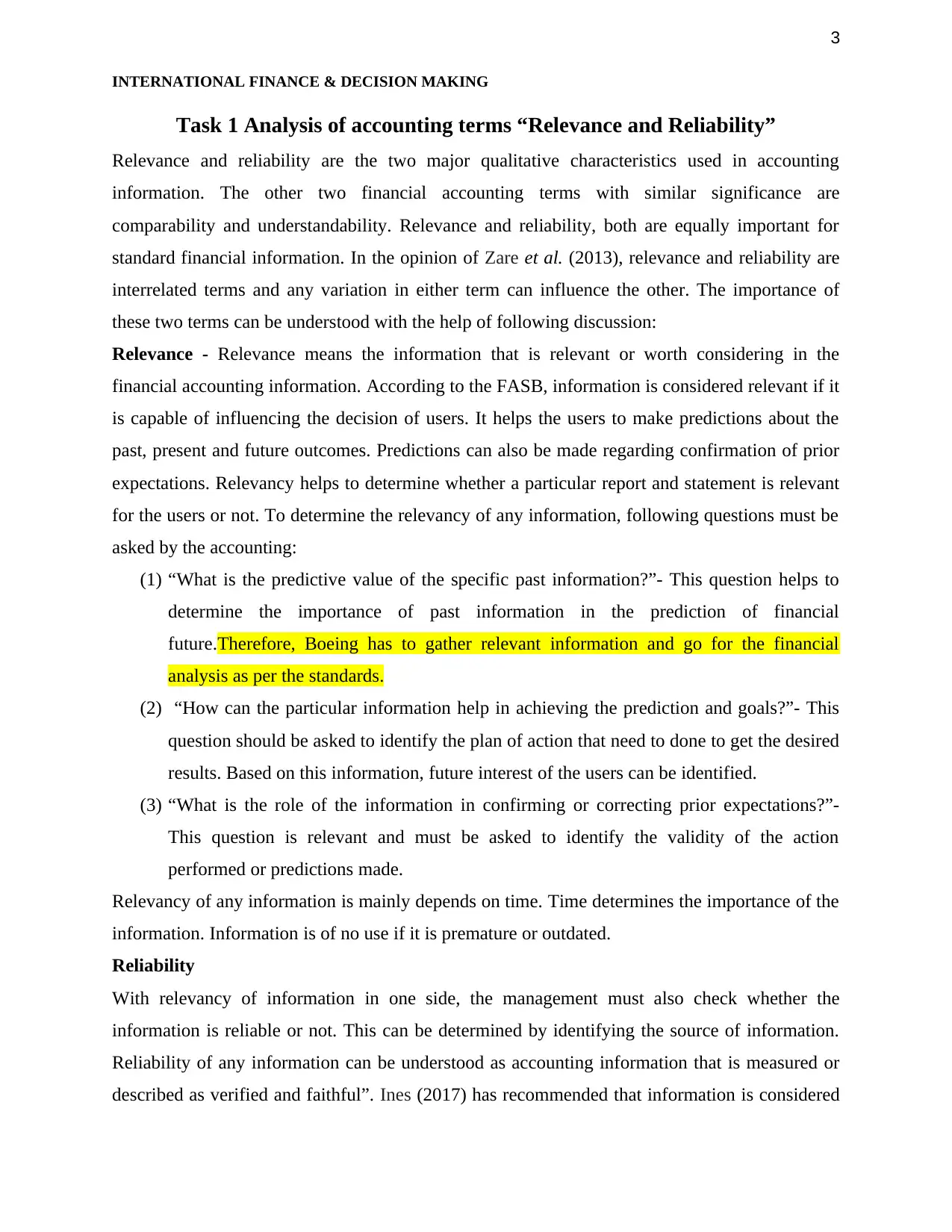
3
INTERNATIONAL FINANCE & DECISION MAKING
Task 1 Analysis of accounting terms “Relevance and Reliability”
Relevance and reliability are the two major qualitative characteristics used in accounting
information. The other two financial accounting terms with similar significance are
comparability and understandability. Relevance and reliability, both are equally important for
standard financial information. In the opinion of Zare et al. (2013), relevance and reliability are
interrelated terms and any variation in either term can influence the other. The importance of
these two terms can be understood with the help of following discussion:
Relevance - Relevance means the information that is relevant or worth considering in the
financial accounting information. According to the FASB, information is considered relevant if it
is capable of influencing the decision of users. It helps the users to make predictions about the
past, present and future outcomes. Predictions can also be made regarding confirmation of prior
expectations. Relevancy helps to determine whether a particular report and statement is relevant
for the users or not. To determine the relevancy of any information, following questions must be
asked by the accounting:
(1) “What is the predictive value of the specific past information?”- This question helps to
determine the importance of past information in the prediction of financial
future.Therefore, Boeing has to gather relevant information and go for the financial
analysis as per the standards.
(2) “How can the particular information help in achieving the prediction and goals?”- This
question should be asked to identify the plan of action that need to done to get the desired
results. Based on this information, future interest of the users can be identified.
(3) “What is the role of the information in confirming or correcting prior expectations?”-
This question is relevant and must be asked to identify the validity of the action
performed or predictions made.
Relevancy of any information is mainly depends on time. Time determines the importance of the
information. Information is of no use if it is premature or outdated.
Reliability
With relevancy of information in one side, the management must also check whether the
information is reliable or not. This can be determined by identifying the source of information.
Reliability of any information can be understood as accounting information that is measured or
described as verified and faithful”. Ines (2017) has recommended that information is considered
INTERNATIONAL FINANCE & DECISION MAKING
Task 1 Analysis of accounting terms “Relevance and Reliability”
Relevance and reliability are the two major qualitative characteristics used in accounting
information. The other two financial accounting terms with similar significance are
comparability and understandability. Relevance and reliability, both are equally important for
standard financial information. In the opinion of Zare et al. (2013), relevance and reliability are
interrelated terms and any variation in either term can influence the other. The importance of
these two terms can be understood with the help of following discussion:
Relevance - Relevance means the information that is relevant or worth considering in the
financial accounting information. According to the FASB, information is considered relevant if it
is capable of influencing the decision of users. It helps the users to make predictions about the
past, present and future outcomes. Predictions can also be made regarding confirmation of prior
expectations. Relevancy helps to determine whether a particular report and statement is relevant
for the users or not. To determine the relevancy of any information, following questions must be
asked by the accounting:
(1) “What is the predictive value of the specific past information?”- This question helps to
determine the importance of past information in the prediction of financial
future.Therefore, Boeing has to gather relevant information and go for the financial
analysis as per the standards.
(2) “How can the particular information help in achieving the prediction and goals?”- This
question should be asked to identify the plan of action that need to done to get the desired
results. Based on this information, future interest of the users can be identified.
(3) “What is the role of the information in confirming or correcting prior expectations?”-
This question is relevant and must be asked to identify the validity of the action
performed or predictions made.
Relevancy of any information is mainly depends on time. Time determines the importance of the
information. Information is of no use if it is premature or outdated.
Reliability
With relevancy of information in one side, the management must also check whether the
information is reliable or not. This can be determined by identifying the source of information.
Reliability of any information can be understood as accounting information that is measured or
described as verified and faithful”. Ines (2017) has recommended that information is considered
⊘ This is a preview!⊘
Do you want full access?
Subscribe today to unlock all pages.

Trusted by 1+ million students worldwide
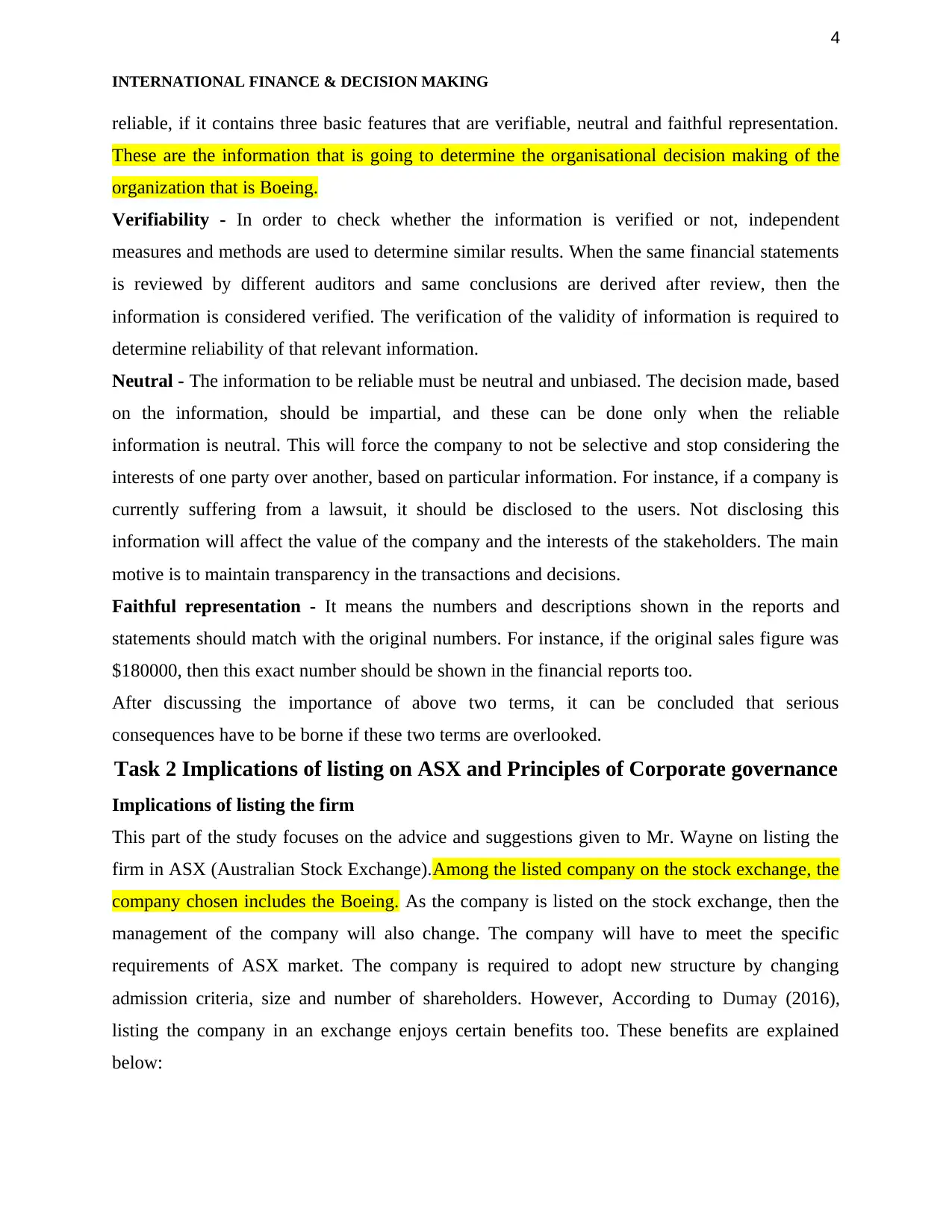
4
INTERNATIONAL FINANCE & DECISION MAKING
reliable, if it contains three basic features that are verifiable, neutral and faithful representation.
These are the information that is going to determine the organisational decision making of the
organization that is Boeing.
Verifiability - In order to check whether the information is verified or not, independent
measures and methods are used to determine similar results. When the same financial statements
is reviewed by different auditors and same conclusions are derived after review, then the
information is considered verified. The verification of the validity of information is required to
determine reliability of that relevant information.
Neutral - The information to be reliable must be neutral and unbiased. The decision made, based
on the information, should be impartial, and these can be done only when the reliable
information is neutral. This will force the company to not be selective and stop considering the
interests of one party over another, based on particular information. For instance, if a company is
currently suffering from a lawsuit, it should be disclosed to the users. Not disclosing this
information will affect the value of the company and the interests of the stakeholders. The main
motive is to maintain transparency in the transactions and decisions.
Faithful representation - It means the numbers and descriptions shown in the reports and
statements should match with the original numbers. For instance, if the original sales figure was
$180000, then this exact number should be shown in the financial reports too.
After discussing the importance of above two terms, it can be concluded that serious
consequences have to be borne if these two terms are overlooked.
Task 2 Implications of listing on ASX and Principles of Corporate governance
Implications of listing the firm
This part of the study focuses on the advice and suggestions given to Mr. Wayne on listing the
firm in ASX (Australian Stock Exchange).Among the listed company on the stock exchange, the
company chosen includes the Boeing. As the company is listed on the stock exchange, then the
management of the company will also change. The company will have to meet the specific
requirements of ASX market. The company is required to adopt new structure by changing
admission criteria, size and number of shareholders. However, According to Dumay (2016),
listing the company in an exchange enjoys certain benefits too. These benefits are explained
below:
INTERNATIONAL FINANCE & DECISION MAKING
reliable, if it contains three basic features that are verifiable, neutral and faithful representation.
These are the information that is going to determine the organisational decision making of the
organization that is Boeing.
Verifiability - In order to check whether the information is verified or not, independent
measures and methods are used to determine similar results. When the same financial statements
is reviewed by different auditors and same conclusions are derived after review, then the
information is considered verified. The verification of the validity of information is required to
determine reliability of that relevant information.
Neutral - The information to be reliable must be neutral and unbiased. The decision made, based
on the information, should be impartial, and these can be done only when the reliable
information is neutral. This will force the company to not be selective and stop considering the
interests of one party over another, based on particular information. For instance, if a company is
currently suffering from a lawsuit, it should be disclosed to the users. Not disclosing this
information will affect the value of the company and the interests of the stakeholders. The main
motive is to maintain transparency in the transactions and decisions.
Faithful representation - It means the numbers and descriptions shown in the reports and
statements should match with the original numbers. For instance, if the original sales figure was
$180000, then this exact number should be shown in the financial reports too.
After discussing the importance of above two terms, it can be concluded that serious
consequences have to be borne if these two terms are overlooked.
Task 2 Implications of listing on ASX and Principles of Corporate governance
Implications of listing the firm
This part of the study focuses on the advice and suggestions given to Mr. Wayne on listing the
firm in ASX (Australian Stock Exchange).Among the listed company on the stock exchange, the
company chosen includes the Boeing. As the company is listed on the stock exchange, then the
management of the company will also change. The company will have to meet the specific
requirements of ASX market. The company is required to adopt new structure by changing
admission criteria, size and number of shareholders. However, According to Dumay (2016),
listing the company in an exchange enjoys certain benefits too. These benefits are explained
below:
Paraphrase This Document
Need a fresh take? Get an instant paraphrase of this document with our AI Paraphraser
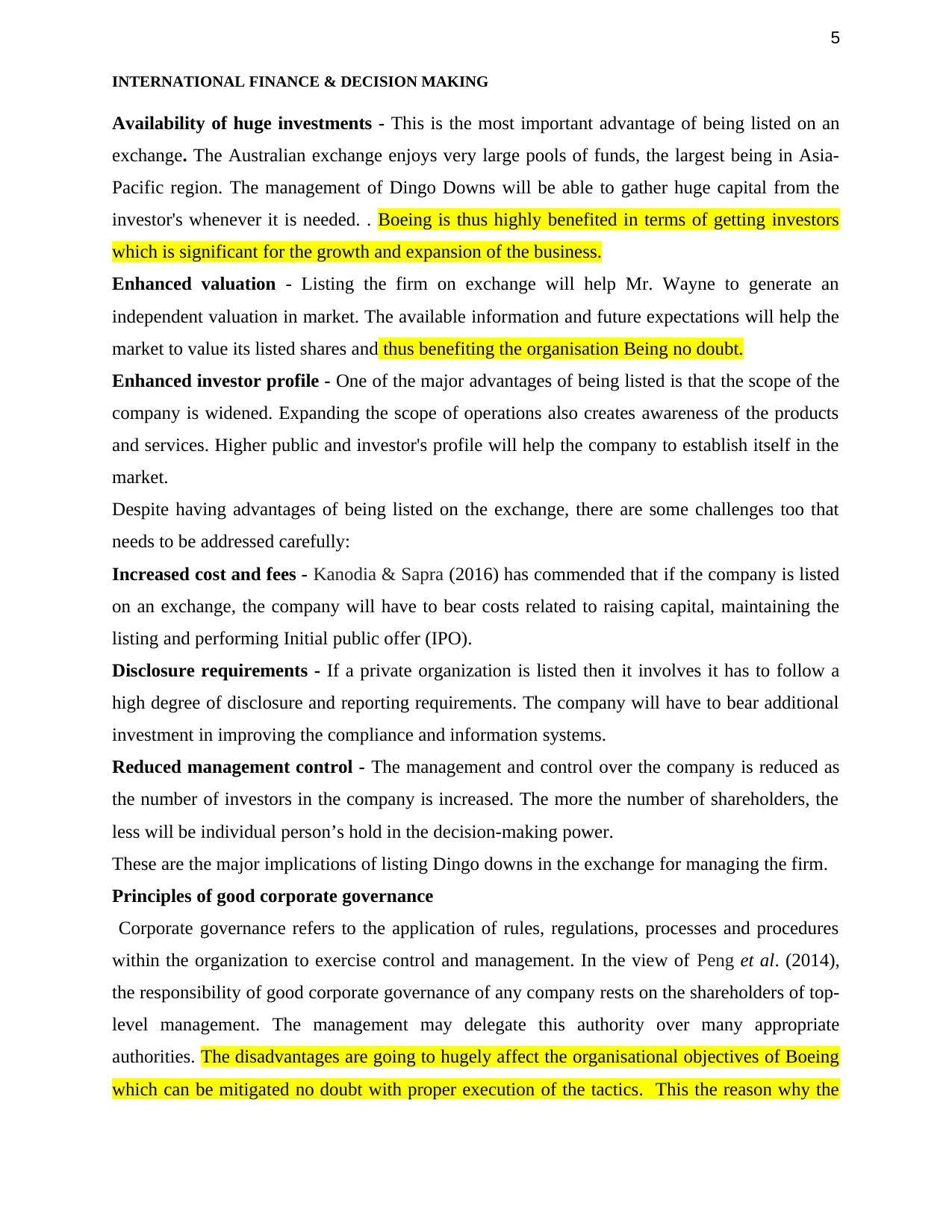
5
INTERNATIONAL FINANCE & DECISION MAKING
Availability of huge investments - This is the most important advantage of being listed on an
exchange. The Australian exchange enjoys very large pools of funds, the largest being in Asia-
Pacific region. The management of Dingo Downs will be able to gather huge capital from the
investor's whenever it is needed. . Boeing is thus highly benefited in terms of getting investors
which is significant for the growth and expansion of the business.
Enhanced valuation - Listing the firm on exchange will help Mr. Wayne to generate an
independent valuation in market. The available information and future expectations will help the
market to value its listed shares and thus benefiting the organisation Being no doubt.
Enhanced investor profile - One of the major advantages of being listed is that the scope of the
company is widened. Expanding the scope of operations also creates awareness of the products
and services. Higher public and investor's profile will help the company to establish itself in the
market.
Despite having advantages of being listed on the exchange, there are some challenges too that
needs to be addressed carefully:
Increased cost and fees - Kanodia & Sapra (2016) has commended that if the company is listed
on an exchange, the company will have to bear costs related to raising capital, maintaining the
listing and performing Initial public offer (IPO).
Disclosure requirements - If a private organization is listed then it involves it has to follow a
high degree of disclosure and reporting requirements. The company will have to bear additional
investment in improving the compliance and information systems.
Reduced management control - The management and control over the company is reduced as
the number of investors in the company is increased. The more the number of shareholders, the
less will be individual person’s hold in the decision-making power.
These are the major implications of listing Dingo downs in the exchange for managing the firm.
Principles of good corporate governance
Corporate governance refers to the application of rules, regulations, processes and procedures
within the organization to exercise control and management. In the view of Peng et al. (2014),
the responsibility of good corporate governance of any company rests on the shareholders of top-
level management. The management may delegate this authority over many appropriate
authorities. The disadvantages are going to hugely affect the organisational objectives of Boeing
which can be mitigated no doubt with proper execution of the tactics. This the reason why the
INTERNATIONAL FINANCE & DECISION MAKING
Availability of huge investments - This is the most important advantage of being listed on an
exchange. The Australian exchange enjoys very large pools of funds, the largest being in Asia-
Pacific region. The management of Dingo Downs will be able to gather huge capital from the
investor's whenever it is needed. . Boeing is thus highly benefited in terms of getting investors
which is significant for the growth and expansion of the business.
Enhanced valuation - Listing the firm on exchange will help Mr. Wayne to generate an
independent valuation in market. The available information and future expectations will help the
market to value its listed shares and thus benefiting the organisation Being no doubt.
Enhanced investor profile - One of the major advantages of being listed is that the scope of the
company is widened. Expanding the scope of operations also creates awareness of the products
and services. Higher public and investor's profile will help the company to establish itself in the
market.
Despite having advantages of being listed on the exchange, there are some challenges too that
needs to be addressed carefully:
Increased cost and fees - Kanodia & Sapra (2016) has commended that if the company is listed
on an exchange, the company will have to bear costs related to raising capital, maintaining the
listing and performing Initial public offer (IPO).
Disclosure requirements - If a private organization is listed then it involves it has to follow a
high degree of disclosure and reporting requirements. The company will have to bear additional
investment in improving the compliance and information systems.
Reduced management control - The management and control over the company is reduced as
the number of investors in the company is increased. The more the number of shareholders, the
less will be individual person’s hold in the decision-making power.
These are the major implications of listing Dingo downs in the exchange for managing the firm.
Principles of good corporate governance
Corporate governance refers to the application of rules, regulations, processes and procedures
within the organization to exercise control and management. In the view of Peng et al. (2014),
the responsibility of good corporate governance of any company rests on the shareholders of top-
level management. The management may delegate this authority over many appropriate
authorities. The disadvantages are going to hugely affect the organisational objectives of Boeing
which can be mitigated no doubt with proper execution of the tactics. This the reason why the
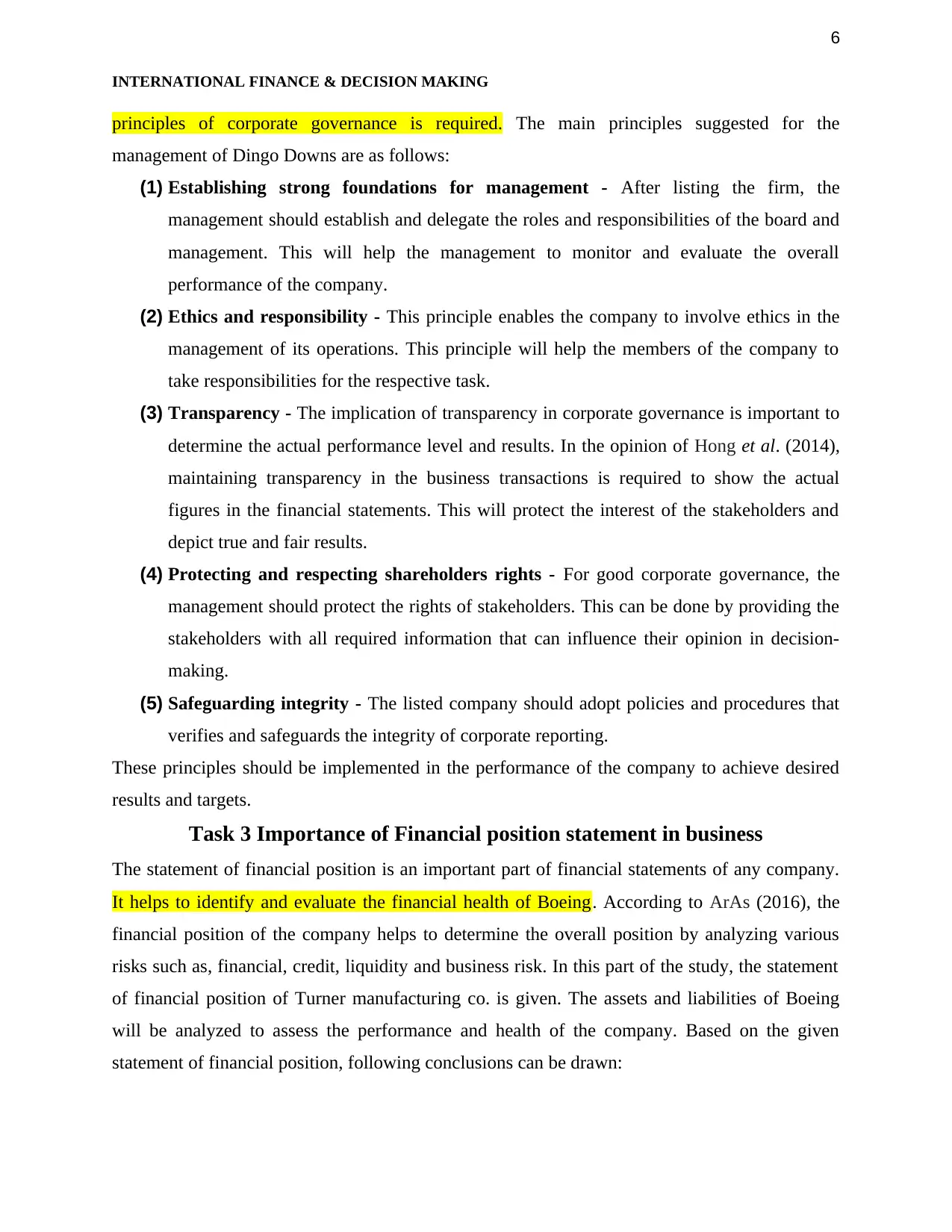
6
INTERNATIONAL FINANCE & DECISION MAKING
principles of corporate governance is required. The main principles suggested for the
management of Dingo Downs are as follows:
(1) Establishing strong foundations for management - After listing the firm, the
management should establish and delegate the roles and responsibilities of the board and
management. This will help the management to monitor and evaluate the overall
performance of the company.
(2) Ethics and responsibility - This principle enables the company to involve ethics in the
management of its operations. This principle will help the members of the company to
take responsibilities for the respective task.
(3) Transparency - The implication of transparency in corporate governance is important to
determine the actual performance level and results. In the opinion of Hong et al. (2014),
maintaining transparency in the business transactions is required to show the actual
figures in the financial statements. This will protect the interest of the stakeholders and
depict true and fair results.
(4) Protecting and respecting shareholders rights - For good corporate governance, the
management should protect the rights of stakeholders. This can be done by providing the
stakeholders with all required information that can influence their opinion in decision-
making.
(5) Safeguarding integrity - The listed company should adopt policies and procedures that
verifies and safeguards the integrity of corporate reporting.
These principles should be implemented in the performance of the company to achieve desired
results and targets.
Task 3 Importance of Financial position statement in business
The statement of financial position is an important part of financial statements of any company.
It helps to identify and evaluate the financial health of Boeing. According to ArAs (2016), the
financial position of the company helps to determine the overall position by analyzing various
risks such as, financial, credit, liquidity and business risk. In this part of the study, the statement
of financial position of Turner manufacturing co. is given. The assets and liabilities of Boeing
will be analyzed to assess the performance and health of the company. Based on the given
statement of financial position, following conclusions can be drawn:
INTERNATIONAL FINANCE & DECISION MAKING
principles of corporate governance is required. The main principles suggested for the
management of Dingo Downs are as follows:
(1) Establishing strong foundations for management - After listing the firm, the
management should establish and delegate the roles and responsibilities of the board and
management. This will help the management to monitor and evaluate the overall
performance of the company.
(2) Ethics and responsibility - This principle enables the company to involve ethics in the
management of its operations. This principle will help the members of the company to
take responsibilities for the respective task.
(3) Transparency - The implication of transparency in corporate governance is important to
determine the actual performance level and results. In the opinion of Hong et al. (2014),
maintaining transparency in the business transactions is required to show the actual
figures in the financial statements. This will protect the interest of the stakeholders and
depict true and fair results.
(4) Protecting and respecting shareholders rights - For good corporate governance, the
management should protect the rights of stakeholders. This can be done by providing the
stakeholders with all required information that can influence their opinion in decision-
making.
(5) Safeguarding integrity - The listed company should adopt policies and procedures that
verifies and safeguards the integrity of corporate reporting.
These principles should be implemented in the performance of the company to achieve desired
results and targets.
Task 3 Importance of Financial position statement in business
The statement of financial position is an important part of financial statements of any company.
It helps to identify and evaluate the financial health of Boeing. According to ArAs (2016), the
financial position of the company helps to determine the overall position by analyzing various
risks such as, financial, credit, liquidity and business risk. In this part of the study, the statement
of financial position of Turner manufacturing co. is given. The assets and liabilities of Boeing
will be analyzed to assess the performance and health of the company. Based on the given
statement of financial position, following conclusions can be drawn:
⊘ This is a preview!⊘
Do you want full access?
Subscribe today to unlock all pages.

Trusted by 1+ million students worldwide
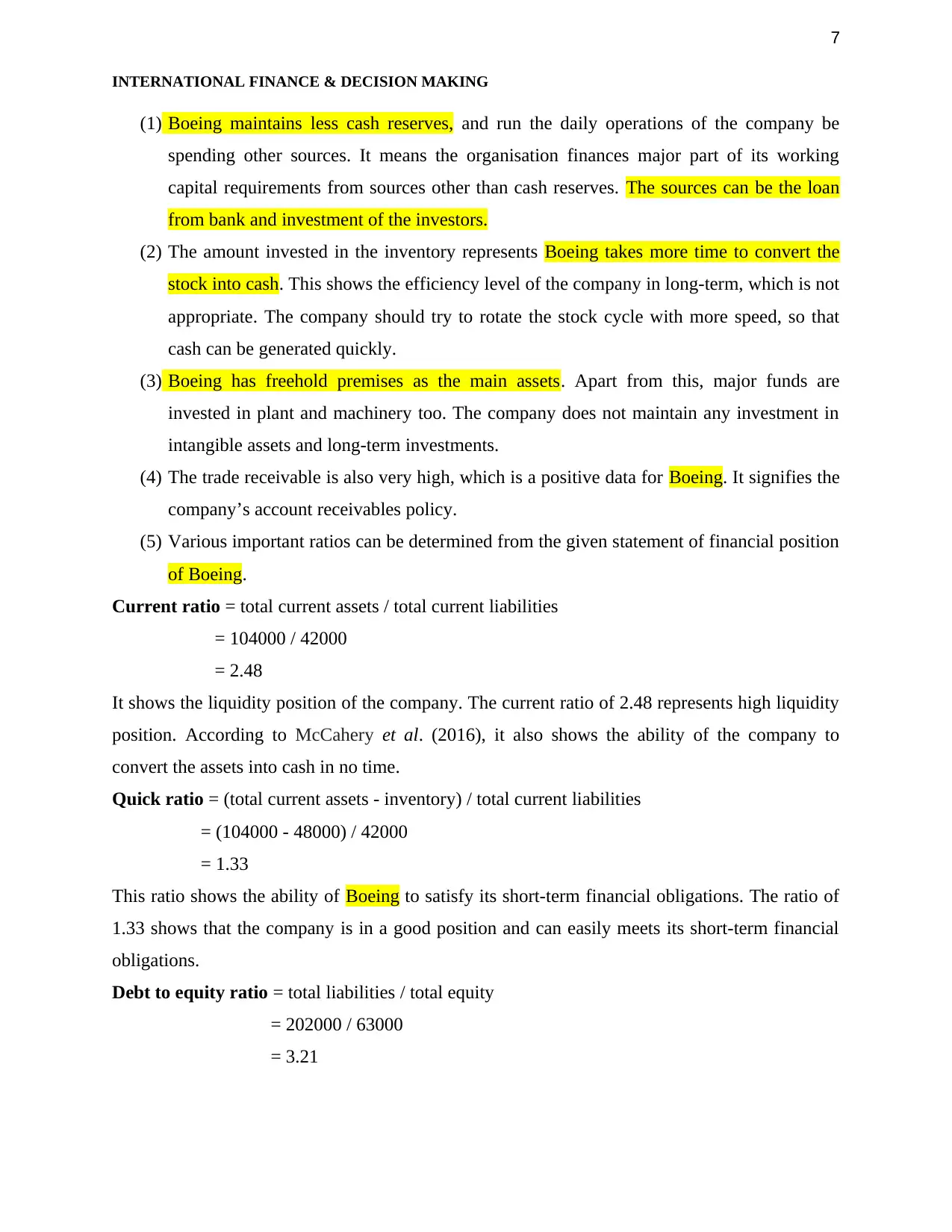
7
INTERNATIONAL FINANCE & DECISION MAKING
(1) Boeing maintains less cash reserves, and run the daily operations of the company be
spending other sources. It means the organisation finances major part of its working
capital requirements from sources other than cash reserves. The sources can be the loan
from bank and investment of the investors.
(2) The amount invested in the inventory represents Boeing takes more time to convert the
stock into cash. This shows the efficiency level of the company in long-term, which is not
appropriate. The company should try to rotate the stock cycle with more speed, so that
cash can be generated quickly.
(3) Boeing has freehold premises as the main assets. Apart from this, major funds are
invested in plant and machinery too. The company does not maintain any investment in
intangible assets and long-term investments.
(4) The trade receivable is also very high, which is a positive data for Boeing. It signifies the
company’s account receivables policy.
(5) Various important ratios can be determined from the given statement of financial position
of Boeing.
Current ratio = total current assets / total current liabilities
= 104000 / 42000
= 2.48
It shows the liquidity position of the company. The current ratio of 2.48 represents high liquidity
position. According to McCahery et al. (2016), it also shows the ability of the company to
convert the assets into cash in no time.
Quick ratio = (total current assets - inventory) / total current liabilities
= (104000 - 48000) / 42000
= 1.33
This ratio shows the ability of Boeing to satisfy its short-term financial obligations. The ratio of
1.33 shows that the company is in a good position and can easily meets its short-term financial
obligations.
Debt to equity ratio = total liabilities / total equity
= 202000 / 63000
= 3.21
INTERNATIONAL FINANCE & DECISION MAKING
(1) Boeing maintains less cash reserves, and run the daily operations of the company be
spending other sources. It means the organisation finances major part of its working
capital requirements from sources other than cash reserves. The sources can be the loan
from bank and investment of the investors.
(2) The amount invested in the inventory represents Boeing takes more time to convert the
stock into cash. This shows the efficiency level of the company in long-term, which is not
appropriate. The company should try to rotate the stock cycle with more speed, so that
cash can be generated quickly.
(3) Boeing has freehold premises as the main assets. Apart from this, major funds are
invested in plant and machinery too. The company does not maintain any investment in
intangible assets and long-term investments.
(4) The trade receivable is also very high, which is a positive data for Boeing. It signifies the
company’s account receivables policy.
(5) Various important ratios can be determined from the given statement of financial position
of Boeing.
Current ratio = total current assets / total current liabilities
= 104000 / 42000
= 2.48
It shows the liquidity position of the company. The current ratio of 2.48 represents high liquidity
position. According to McCahery et al. (2016), it also shows the ability of the company to
convert the assets into cash in no time.
Quick ratio = (total current assets - inventory) / total current liabilities
= (104000 - 48000) / 42000
= 1.33
This ratio shows the ability of Boeing to satisfy its short-term financial obligations. The ratio of
1.33 shows that the company is in a good position and can easily meets its short-term financial
obligations.
Debt to equity ratio = total liabilities / total equity
= 202000 / 63000
= 3.21
Paraphrase This Document
Need a fresh take? Get an instant paraphrase of this document with our AI Paraphraser
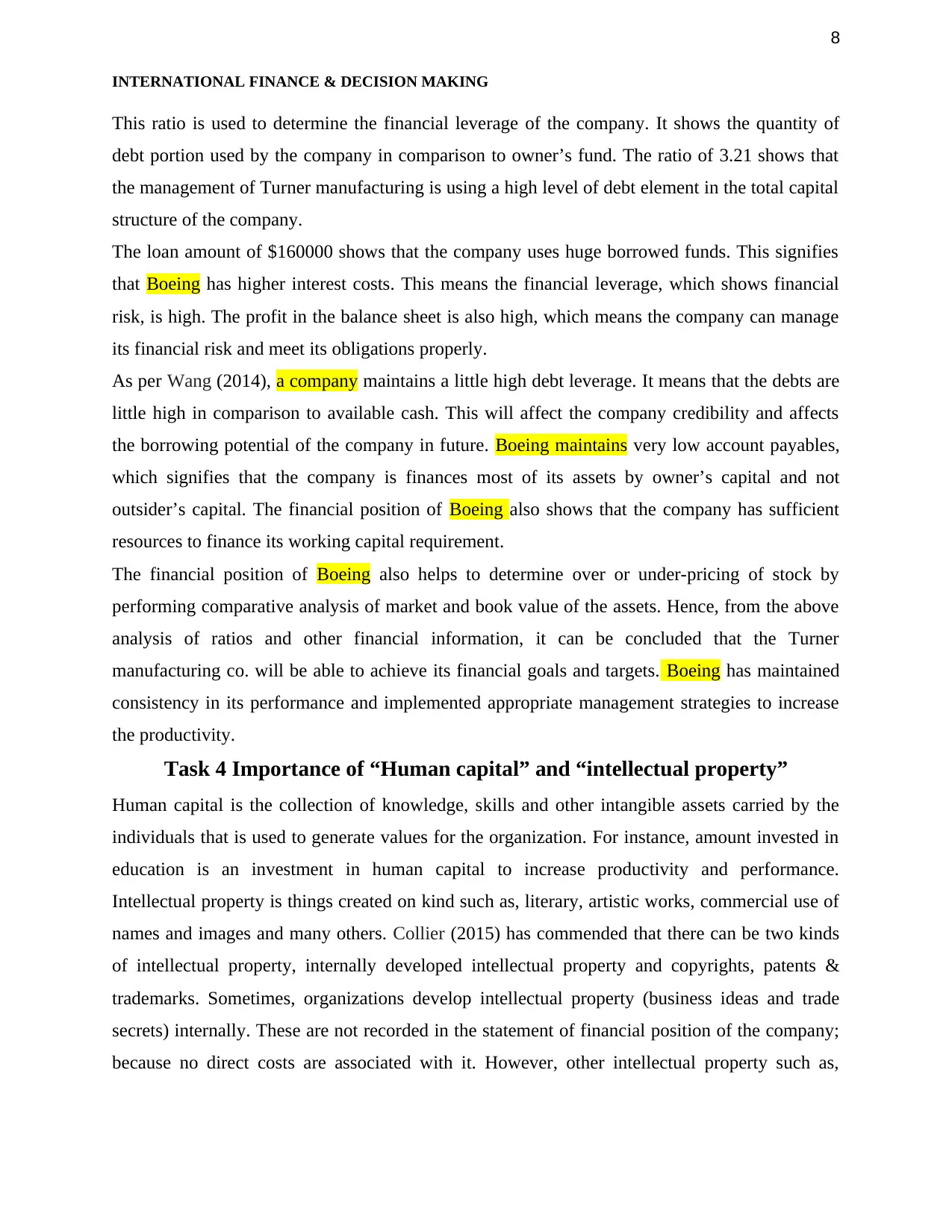
8
INTERNATIONAL FINANCE & DECISION MAKING
This ratio is used to determine the financial leverage of the company. It shows the quantity of
debt portion used by the company in comparison to owner’s fund. The ratio of 3.21 shows that
the management of Turner manufacturing is using a high level of debt element in the total capital
structure of the company.
The loan amount of $160000 shows that the company uses huge borrowed funds. This signifies
that Boeing has higher interest costs. This means the financial leverage, which shows financial
risk, is high. The profit in the balance sheet is also high, which means the company can manage
its financial risk and meet its obligations properly.
As per Wang (2014), a company maintains a little high debt leverage. It means that the debts are
little high in comparison to available cash. This will affect the company credibility and affects
the borrowing potential of the company in future. Boeing maintains very low account payables,
which signifies that the company is finances most of its assets by owner’s capital and not
outsider’s capital. The financial position of Boeing also shows that the company has sufficient
resources to finance its working capital requirement.
The financial position of Boeing also helps to determine over or under-pricing of stock by
performing comparative analysis of market and book value of the assets. Hence, from the above
analysis of ratios and other financial information, it can be concluded that the Turner
manufacturing co. will be able to achieve its financial goals and targets. Boeing has maintained
consistency in its performance and implemented appropriate management strategies to increase
the productivity.
Task 4 Importance of “Human capital” and “intellectual property”
Human capital is the collection of knowledge, skills and other intangible assets carried by the
individuals that is used to generate values for the organization. For instance, amount invested in
education is an investment in human capital to increase productivity and performance.
Intellectual property is things created on kind such as, literary, artistic works, commercial use of
names and images and many others. Collier (2015) has commended that there can be two kinds
of intellectual property, internally developed intellectual property and copyrights, patents &
trademarks. Sometimes, organizations develop intellectual property (business ideas and trade
secrets) internally. These are not recorded in the statement of financial position of the company;
because no direct costs are associated with it. However, other intellectual property such as,
INTERNATIONAL FINANCE & DECISION MAKING
This ratio is used to determine the financial leverage of the company. It shows the quantity of
debt portion used by the company in comparison to owner’s fund. The ratio of 3.21 shows that
the management of Turner manufacturing is using a high level of debt element in the total capital
structure of the company.
The loan amount of $160000 shows that the company uses huge borrowed funds. This signifies
that Boeing has higher interest costs. This means the financial leverage, which shows financial
risk, is high. The profit in the balance sheet is also high, which means the company can manage
its financial risk and meet its obligations properly.
As per Wang (2014), a company maintains a little high debt leverage. It means that the debts are
little high in comparison to available cash. This will affect the company credibility and affects
the borrowing potential of the company in future. Boeing maintains very low account payables,
which signifies that the company is finances most of its assets by owner’s capital and not
outsider’s capital. The financial position of Boeing also shows that the company has sufficient
resources to finance its working capital requirement.
The financial position of Boeing also helps to determine over or under-pricing of stock by
performing comparative analysis of market and book value of the assets. Hence, from the above
analysis of ratios and other financial information, it can be concluded that the Turner
manufacturing co. will be able to achieve its financial goals and targets. Boeing has maintained
consistency in its performance and implemented appropriate management strategies to increase
the productivity.
Task 4 Importance of “Human capital” and “intellectual property”
Human capital is the collection of knowledge, skills and other intangible assets carried by the
individuals that is used to generate values for the organization. For instance, amount invested in
education is an investment in human capital to increase productivity and performance.
Intellectual property is things created on kind such as, literary, artistic works, commercial use of
names and images and many others. Collier (2015) has commended that there can be two kinds
of intellectual property, internally developed intellectual property and copyrights, patents &
trademarks. Sometimes, organizations develop intellectual property (business ideas and trade
secrets) internally. These are not recorded in the statement of financial position of the company;
because no direct costs are associated with it. However, other intellectual property such as,
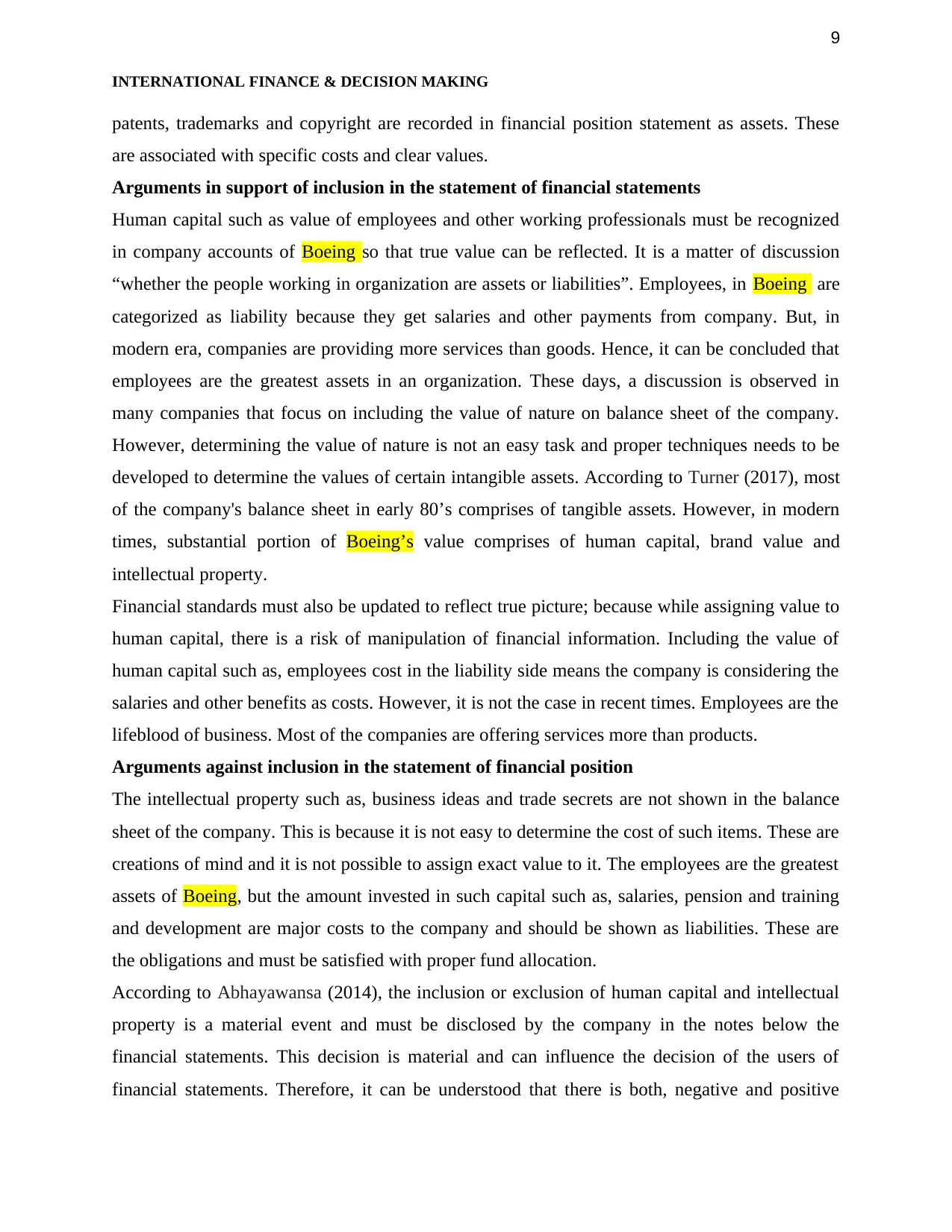
9
INTERNATIONAL FINANCE & DECISION MAKING
patents, trademarks and copyright are recorded in financial position statement as assets. These
are associated with specific costs and clear values.
Arguments in support of inclusion in the statement of financial statements
Human capital such as value of employees and other working professionals must be recognized
in company accounts of Boeing so that true value can be reflected. It is a matter of discussion
“whether the people working in organization are assets or liabilities”. Employees, in Boeing are
categorized as liability because they get salaries and other payments from company. But, in
modern era, companies are providing more services than goods. Hence, it can be concluded that
employees are the greatest assets in an organization. These days, a discussion is observed in
many companies that focus on including the value of nature on balance sheet of the company.
However, determining the value of nature is not an easy task and proper techniques needs to be
developed to determine the values of certain intangible assets. According to Turner (2017), most
of the company's balance sheet in early 80’s comprises of tangible assets. However, in modern
times, substantial portion of Boeing’s value comprises of human capital, brand value and
intellectual property.
Financial standards must also be updated to reflect true picture; because while assigning value to
human capital, there is a risk of manipulation of financial information. Including the value of
human capital such as, employees cost in the liability side means the company is considering the
salaries and other benefits as costs. However, it is not the case in recent times. Employees are the
lifeblood of business. Most of the companies are offering services more than products.
Arguments against inclusion in the statement of financial position
The intellectual property such as, business ideas and trade secrets are not shown in the balance
sheet of the company. This is because it is not easy to determine the cost of such items. These are
creations of mind and it is not possible to assign exact value to it. The employees are the greatest
assets of Boeing, but the amount invested in such capital such as, salaries, pension and training
and development are major costs to the company and should be shown as liabilities. These are
the obligations and must be satisfied with proper fund allocation.
According to Abhayawansa (2014), the inclusion or exclusion of human capital and intellectual
property is a material event and must be disclosed by the company in the notes below the
financial statements. This decision is material and can influence the decision of the users of
financial statements. Therefore, it can be understood that there is both, negative and positive
INTERNATIONAL FINANCE & DECISION MAKING
patents, trademarks and copyright are recorded in financial position statement as assets. These
are associated with specific costs and clear values.
Arguments in support of inclusion in the statement of financial statements
Human capital such as value of employees and other working professionals must be recognized
in company accounts of Boeing so that true value can be reflected. It is a matter of discussion
“whether the people working in organization are assets or liabilities”. Employees, in Boeing are
categorized as liability because they get salaries and other payments from company. But, in
modern era, companies are providing more services than goods. Hence, it can be concluded that
employees are the greatest assets in an organization. These days, a discussion is observed in
many companies that focus on including the value of nature on balance sheet of the company.
However, determining the value of nature is not an easy task and proper techniques needs to be
developed to determine the values of certain intangible assets. According to Turner (2017), most
of the company's balance sheet in early 80’s comprises of tangible assets. However, in modern
times, substantial portion of Boeing’s value comprises of human capital, brand value and
intellectual property.
Financial standards must also be updated to reflect true picture; because while assigning value to
human capital, there is a risk of manipulation of financial information. Including the value of
human capital such as, employees cost in the liability side means the company is considering the
salaries and other benefits as costs. However, it is not the case in recent times. Employees are the
lifeblood of business. Most of the companies are offering services more than products.
Arguments against inclusion in the statement of financial position
The intellectual property such as, business ideas and trade secrets are not shown in the balance
sheet of the company. This is because it is not easy to determine the cost of such items. These are
creations of mind and it is not possible to assign exact value to it. The employees are the greatest
assets of Boeing, but the amount invested in such capital such as, salaries, pension and training
and development are major costs to the company and should be shown as liabilities. These are
the obligations and must be satisfied with proper fund allocation.
According to Abhayawansa (2014), the inclusion or exclusion of human capital and intellectual
property is a material event and must be disclosed by the company in the notes below the
financial statements. This decision is material and can influence the decision of the users of
financial statements. Therefore, it can be understood that there is both, negative and positive
⊘ This is a preview!⊘
Do you want full access?
Subscribe today to unlock all pages.

Trusted by 1+ million students worldwide
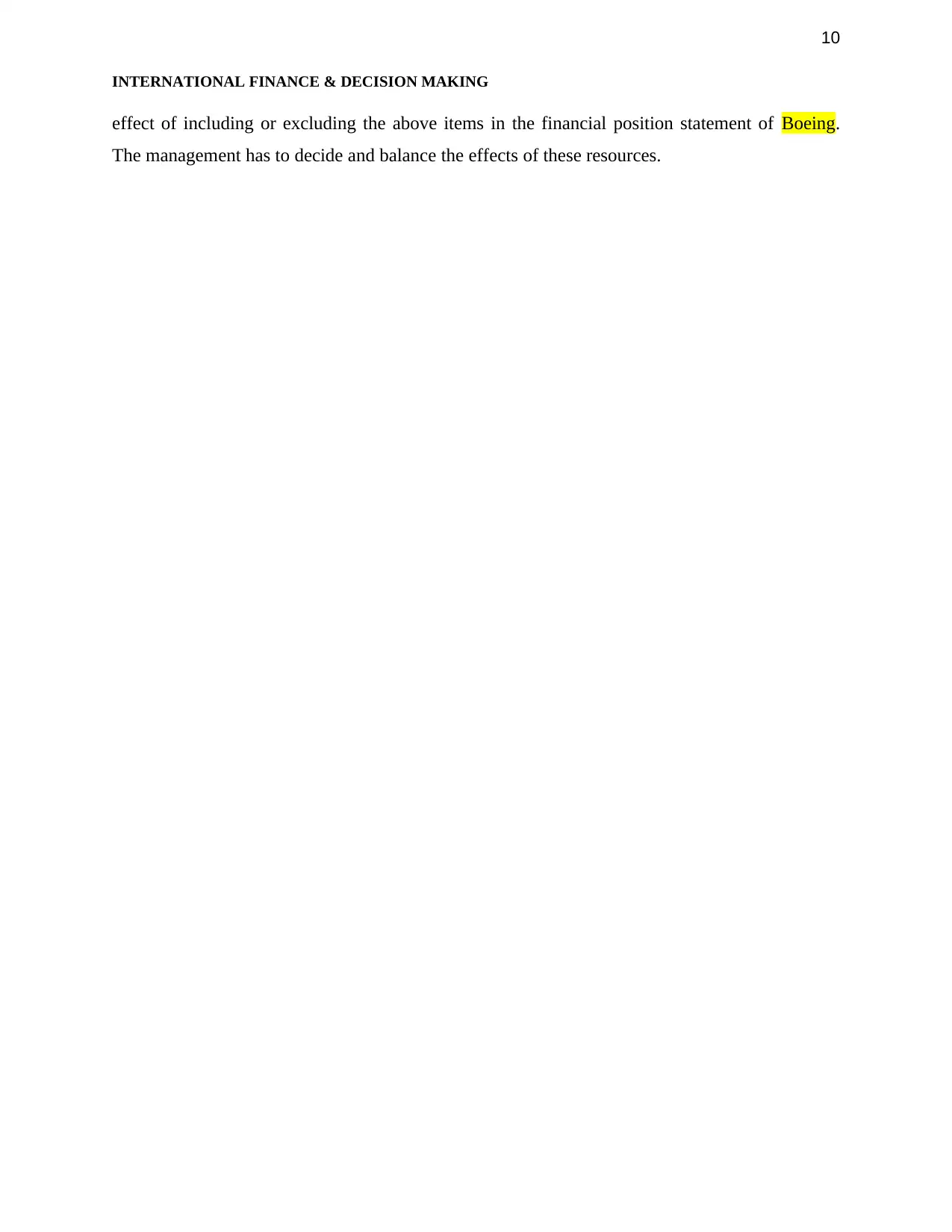
10
INTERNATIONAL FINANCE & DECISION MAKING
effect of including or excluding the above items in the financial position statement of Boeing.
The management has to decide and balance the effects of these resources.
INTERNATIONAL FINANCE & DECISION MAKING
effect of including or excluding the above items in the financial position statement of Boeing.
The management has to decide and balance the effects of these resources.
Paraphrase This Document
Need a fresh take? Get an instant paraphrase of this document with our AI Paraphraser
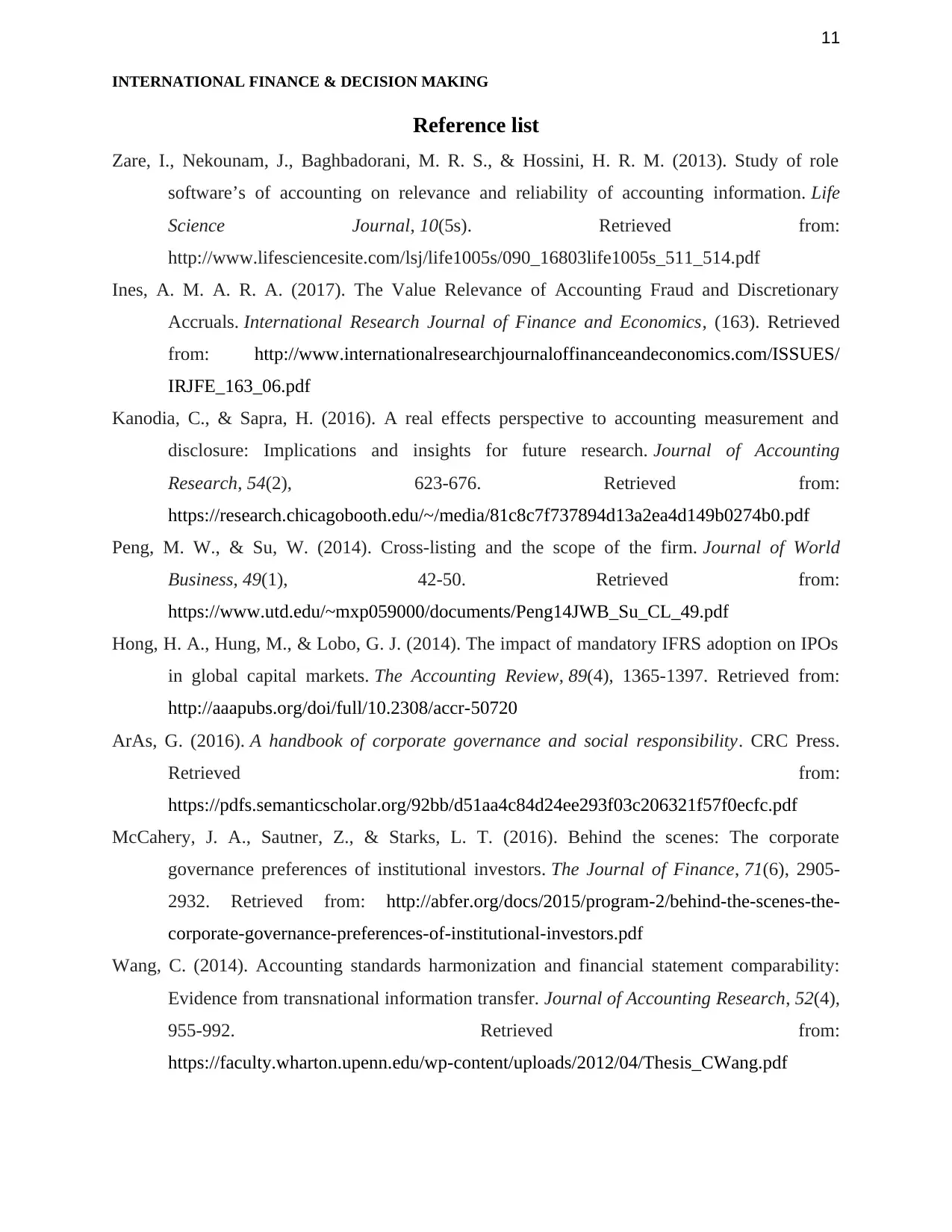
11
INTERNATIONAL FINANCE & DECISION MAKING
Reference list
Zare, I., Nekounam, J., Baghbadorani, M. R. S., & Hossini, H. R. M. (2013). Study of role
software’s of accounting on relevance and reliability of accounting information. Life
Science Journal, 10(5s). Retrieved from:
http://www.lifesciencesite.com/lsj/life1005s/090_16803life1005s_511_514.pdf
Ines, A. M. A. R. A. (2017). The Value Relevance of Accounting Fraud and Discretionary
Accruals. International Research Journal of Finance and Economics, (163). Retrieved
from: http://www.internationalresearchjournaloffinanceandeconomics.com/ISSUES/
IRJFE_163_06.pdf
Kanodia, C., & Sapra, H. (2016). A real effects perspective to accounting measurement and
disclosure: Implications and insights for future research. Journal of Accounting
Research, 54(2), 623-676. Retrieved from:
https://research.chicagobooth.edu/~/media/81c8c7f737894d13a2ea4d149b0274b0.pdf
Peng, M. W., & Su, W. (2014). Cross-listing and the scope of the firm. Journal of World
Business, 49(1), 42-50. Retrieved from:
https://www.utd.edu/~mxp059000/documents/Peng14JWB_Su_CL_49.pdf
Hong, H. A., Hung, M., & Lobo, G. J. (2014). The impact of mandatory IFRS adoption on IPOs
in global capital markets. The Accounting Review, 89(4), 1365-1397. Retrieved from:
http://aaapubs.org/doi/full/10.2308/accr-50720
ArAs, G. (2016). A handbook of corporate governance and social responsibility. CRC Press.
Retrieved from:
https://pdfs.semanticscholar.org/92bb/d51aa4c84d24ee293f03c206321f57f0ecfc.pdf
McCahery, J. A., Sautner, Z., & Starks, L. T. (2016). Behind the scenes: The corporate
governance preferences of institutional investors. The Journal of Finance, 71(6), 2905-
2932. Retrieved from: http://abfer.org/docs/2015/program-2/behind-the-scenes-the-
corporate-governance-preferences-of-institutional-investors.pdf
Wang, C. (2014). Accounting standards harmonization and financial statement comparability:
Evidence from transnational information transfer. Journal of Accounting Research, 52(4),
955-992. Retrieved from:
https://faculty.wharton.upenn.edu/wp-content/uploads/2012/04/Thesis_CWang.pdf
INTERNATIONAL FINANCE & DECISION MAKING
Reference list
Zare, I., Nekounam, J., Baghbadorani, M. R. S., & Hossini, H. R. M. (2013). Study of role
software’s of accounting on relevance and reliability of accounting information. Life
Science Journal, 10(5s). Retrieved from:
http://www.lifesciencesite.com/lsj/life1005s/090_16803life1005s_511_514.pdf
Ines, A. M. A. R. A. (2017). The Value Relevance of Accounting Fraud and Discretionary
Accruals. International Research Journal of Finance and Economics, (163). Retrieved
from: http://www.internationalresearchjournaloffinanceandeconomics.com/ISSUES/
IRJFE_163_06.pdf
Kanodia, C., & Sapra, H. (2016). A real effects perspective to accounting measurement and
disclosure: Implications and insights for future research. Journal of Accounting
Research, 54(2), 623-676. Retrieved from:
https://research.chicagobooth.edu/~/media/81c8c7f737894d13a2ea4d149b0274b0.pdf
Peng, M. W., & Su, W. (2014). Cross-listing and the scope of the firm. Journal of World
Business, 49(1), 42-50. Retrieved from:
https://www.utd.edu/~mxp059000/documents/Peng14JWB_Su_CL_49.pdf
Hong, H. A., Hung, M., & Lobo, G. J. (2014). The impact of mandatory IFRS adoption on IPOs
in global capital markets. The Accounting Review, 89(4), 1365-1397. Retrieved from:
http://aaapubs.org/doi/full/10.2308/accr-50720
ArAs, G. (2016). A handbook of corporate governance and social responsibility. CRC Press.
Retrieved from:
https://pdfs.semanticscholar.org/92bb/d51aa4c84d24ee293f03c206321f57f0ecfc.pdf
McCahery, J. A., Sautner, Z., & Starks, L. T. (2016). Behind the scenes: The corporate
governance preferences of institutional investors. The Journal of Finance, 71(6), 2905-
2932. Retrieved from: http://abfer.org/docs/2015/program-2/behind-the-scenes-the-
corporate-governance-preferences-of-institutional-investors.pdf
Wang, C. (2014). Accounting standards harmonization and financial statement comparability:
Evidence from transnational information transfer. Journal of Accounting Research, 52(4),
955-992. Retrieved from:
https://faculty.wharton.upenn.edu/wp-content/uploads/2012/04/Thesis_CWang.pdf
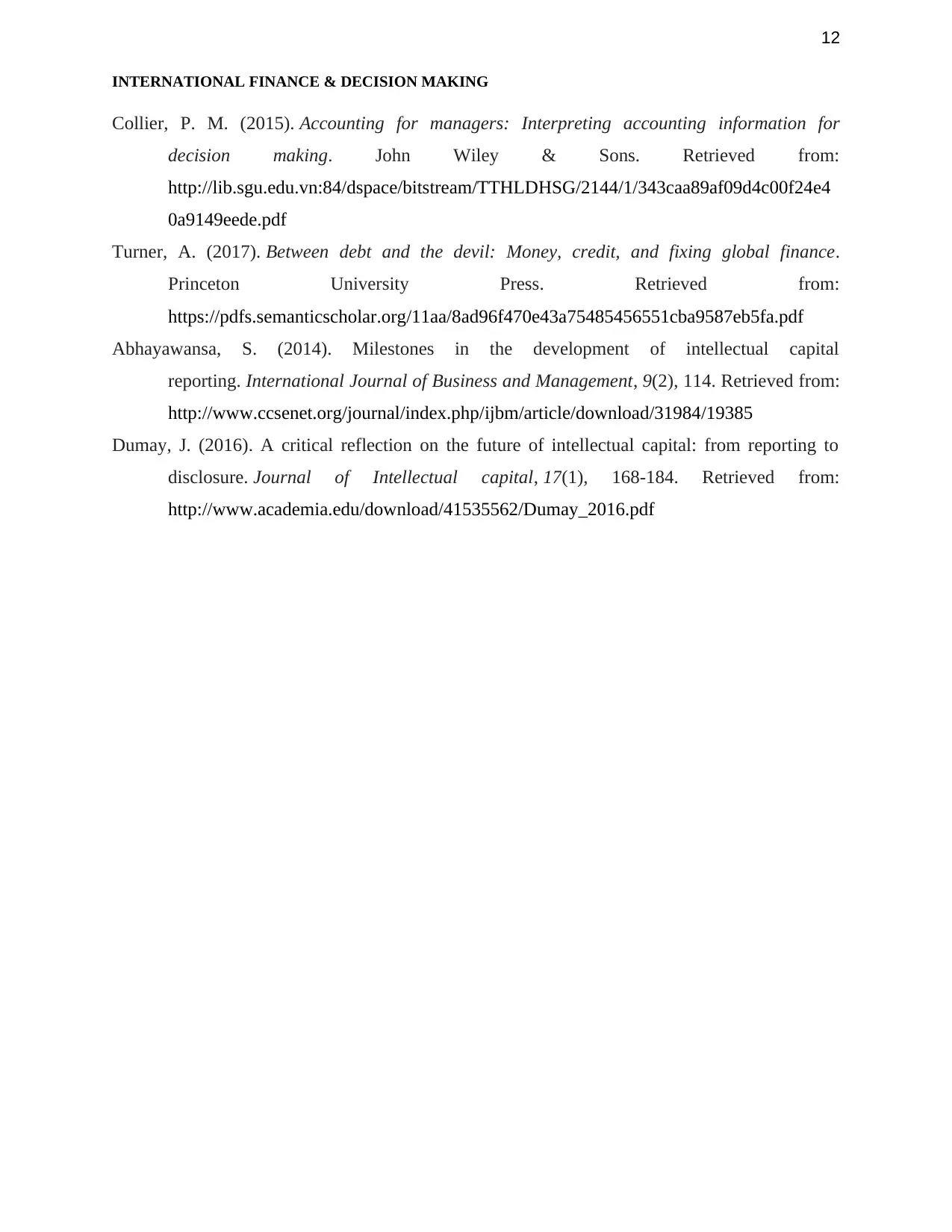
12
INTERNATIONAL FINANCE & DECISION MAKING
Collier, P. M. (2015). Accounting for managers: Interpreting accounting information for
decision making. John Wiley & Sons. Retrieved from:
http://lib.sgu.edu.vn:84/dspace/bitstream/TTHLDHSG/2144/1/343caa89af09d4c00f24e4
0a9149eede.pdf
Turner, A. (2017). Between debt and the devil: Money, credit, and fixing global finance.
Princeton University Press. Retrieved from:
https://pdfs.semanticscholar.org/11aa/8ad96f470e43a75485456551cba9587eb5fa.pdf
Abhayawansa, S. (2014). Milestones in the development of intellectual capital
reporting. International Journal of Business and Management, 9(2), 114. Retrieved from:
http://www.ccsenet.org/journal/index.php/ijbm/article/download/31984/19385
Dumay, J. (2016). A critical reflection on the future of intellectual capital: from reporting to
disclosure. Journal of Intellectual capital, 17(1), 168-184. Retrieved from:
http://www.academia.edu/download/41535562/Dumay_2016.pdf
INTERNATIONAL FINANCE & DECISION MAKING
Collier, P. M. (2015). Accounting for managers: Interpreting accounting information for
decision making. John Wiley & Sons. Retrieved from:
http://lib.sgu.edu.vn:84/dspace/bitstream/TTHLDHSG/2144/1/343caa89af09d4c00f24e4
0a9149eede.pdf
Turner, A. (2017). Between debt and the devil: Money, credit, and fixing global finance.
Princeton University Press. Retrieved from:
https://pdfs.semanticscholar.org/11aa/8ad96f470e43a75485456551cba9587eb5fa.pdf
Abhayawansa, S. (2014). Milestones in the development of intellectual capital
reporting. International Journal of Business and Management, 9(2), 114. Retrieved from:
http://www.ccsenet.org/journal/index.php/ijbm/article/download/31984/19385
Dumay, J. (2016). A critical reflection on the future of intellectual capital: from reporting to
disclosure. Journal of Intellectual capital, 17(1), 168-184. Retrieved from:
http://www.academia.edu/download/41535562/Dumay_2016.pdf
⊘ This is a preview!⊘
Do you want full access?
Subscribe today to unlock all pages.

Trusted by 1+ million students worldwide
1 out of 12
Related Documents
Your All-in-One AI-Powered Toolkit for Academic Success.
+13062052269
info@desklib.com
Available 24*7 on WhatsApp / Email
![[object Object]](/_next/static/media/star-bottom.7253800d.svg)
Unlock your academic potential
Copyright © 2020–2025 A2Z Services. All Rights Reserved. Developed and managed by ZUCOL.





